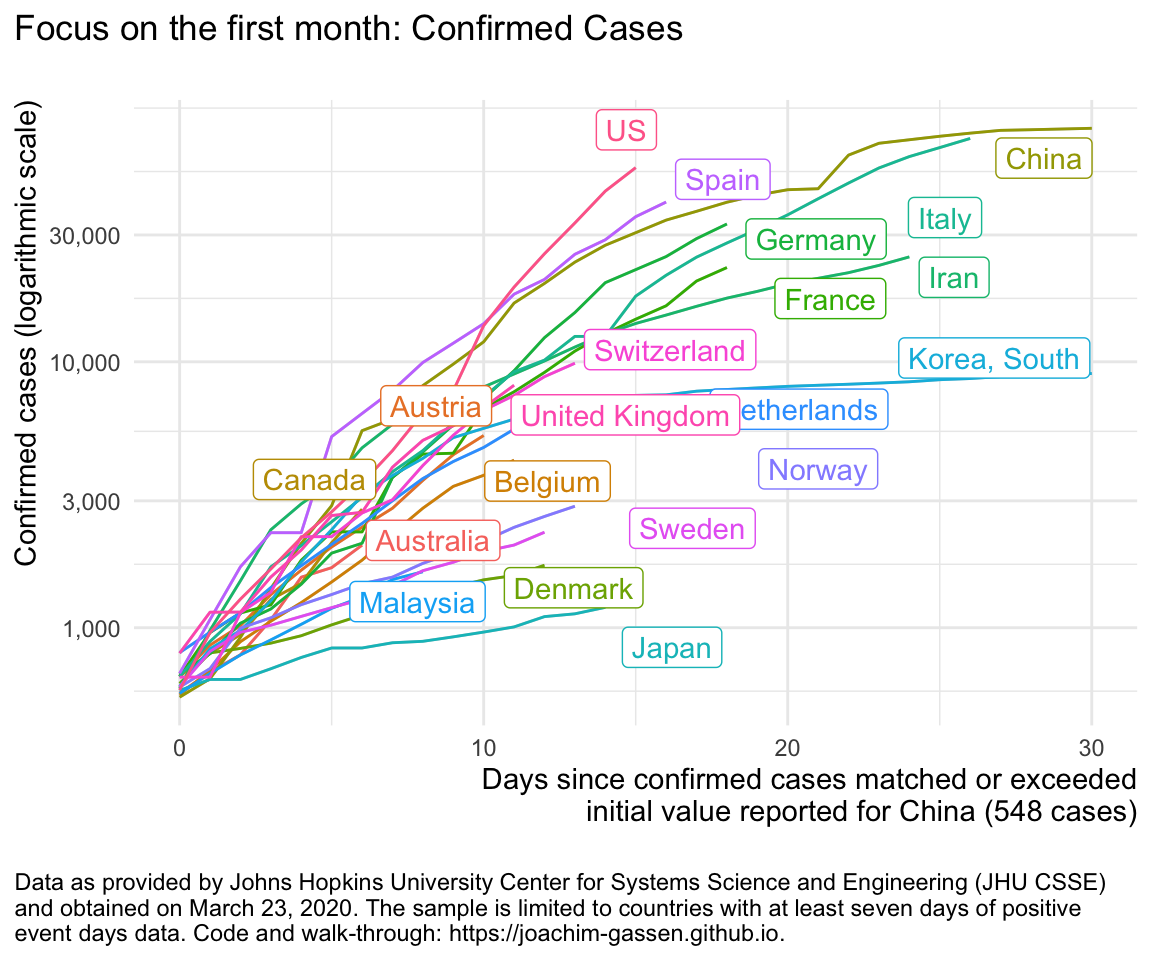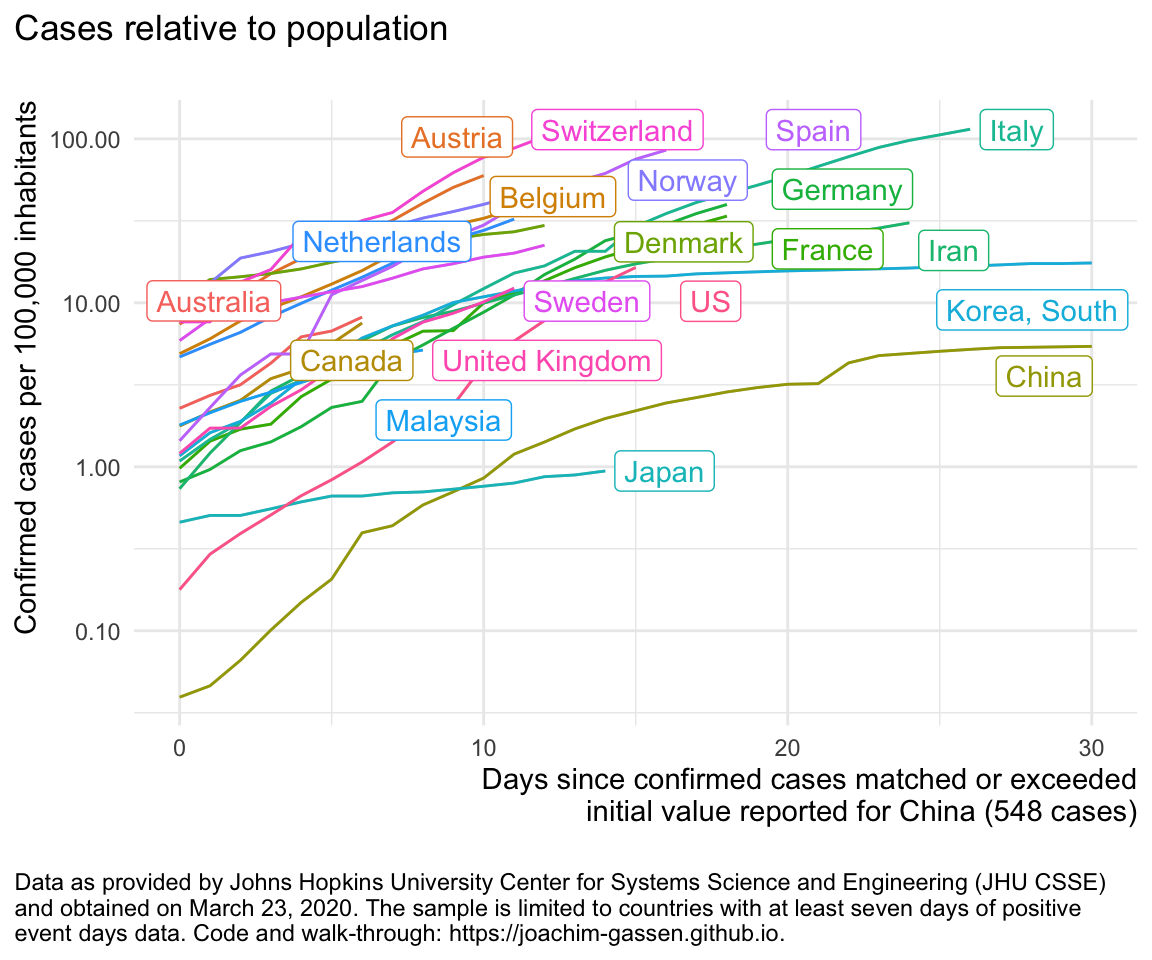Tidying the new Johns Hopkins Covid-19 time-series datasets
Update 2020-03-30: I have decided that the world needs another Covid-19 related R package. Not sure whether you agree, but the new package facilitates the direct download of various Covid-19 related data (including data on governmental measures) directly from the authoritative sources. A short blog post about it can be found here. It also provides a flexible function and accompanying shiny app to visualize the spreading of the virus. Play around with the shiny app here if you like. The repo below stays in place for those of you that rather want to take data collection in their own hands. Please feel free to fork and explore. Stay well and keep #FlattenTheCurve!
Update 2020-03-28: I have created a github repo containing the updated code from below and more. I will try to maintain its code base moving forward. Please feel free to fork and explore. Stay well and keep #FlattenTheCurve!
Update 2020-03-25: I updated the cleaning code to become more robust to future country name changes and to also incorporate the old depreciated data on recoveries for the time being. Thank you to Einar Hjorleifsson and
Angel Angelov in the comments below who brought up the idea to use the countrycode package. Using that package I am now able to remove all hand cleaning. The process now uses iso3c (ISO 3166-1 alpha-3) as identifier and requires each country dimension to have such an identifier. This currently rules out the Kosovo and the Diamond Princess cruise ship data. All other countries are matched. While this might change when the Johns Hopkins CSSE team changes country names or introduces new countries/jurisdictions, thanks to the countrycode package this now will become apparent. So pay attention to those warnings ;-). I moved the old code to the end of the blog in case somebody is interested in the fuzzy matching of country names.
Just hours after my old blog post about tidying Johns Hopkins CSSE Covid-19 data the team has changed their time-series table data structure. The data of the old post is still available but won’t be updated. This new blog post is based on the new times-series data structure. Currently, they only seem to provide time series data on confirmed cases and deaths.
The main reason for me sharing this code is that I did not find code that merges standardized country level identifiers to to the data in a semi-automatic way. These identifiers are important whenever you want to merge additional country level data for additional analyses, like, e.g. population data to calculate per capita measures. Also, I thought that the steps presented below are nice small case on how to obtain, tidy and merge country-level data from public sources.
Pulling and tidying the Johns Hopkins Covid-19 data to long format at the country level
So here is the new code for pulling and tidying the data. After organizing everything by iso3c it merges the country names that are present in the Johns Hopkins data, giving prominence to the names that are present in the crurent datasets.
library(tidyverse)
library(lubridate)
library(countrycode)
clean_jhd_to_long <- function(df) {
df_str <- deparse(substitute(df))
var_str <- substr(df_str, 1, str_length(df_str) - 4)
df %>%
select(-`Province/State`, -Lat, -Long) %>%
rename(country = `Country/Region`) %>%
mutate(iso3c = countrycode(country,
origin = "country.name",
destination = "iso3c")) %>%
select(-country) %>%
filter(!is.na(iso3c)) %>%
group_by(iso3c) %>%
summarise_at(vars(-group_cols()), sum) %>%
pivot_longer(
-iso3c,
names_to = "date_str",
values_to = var_str
) %>%
ungroup() %>%
mutate(date = mdy(date_str)) %>%
select(iso3c, date, !! sym(var_str))
}
confirmed_raw <- read_csv("https://raw.githubusercontent.com/CSSEGISandData/COVID-19/master/csse_covid_19_data/csse_covid_19_time_series/time_series_covid19_confirmed_global.csv", col_types = cols())
deaths_raw <- read_csv("https://raw.githubusercontent.com/CSSEGISandData/COVID-19/master/csse_covid_19_data/csse_covid_19_time_series/time_series_covid19_deaths_global.csv", col_types = cols())
# Recovered data I pull from the old depreciated dataset. This might generate issues going forward
recovered_raw <- read_csv("https://raw.githubusercontent.com/CSSEGISandData/COVID-19/master/csse_covid_19_data/csse_covid_19_time_series/time_series_19-covid-Recovered.csv", col_types = cols())
jh_covid19_data <- clean_jhd_to_long(confirmed_raw) %>%
full_join(clean_jhd_to_long(deaths_raw), by = c("iso3c", "date")) %>%
full_join(clean_jhd_to_long(recovered_raw), by = c("iso3c", "date"))
jhd_countries <- tibble(
country = unique(confirmed_raw$`Country/Region`),
iso3c = countrycode(country,
origin = "country.name",
destination = "iso3c")
) %>% filter(!is.na(iso3c))
old_jhd_countries <- tibble(
country = unique(recovered_raw$`Country/Region`),
iso3c = countrycode(country,
origin = "country.name",
destination = "iso3c")
) %>% filter(!is.na(iso3c),
! iso3c %in% jhd_countries$iso3c)
jhd_countries <- rbind(jhd_countries, old_jhd_countries)
jh_covid19_data %>%
left_join(jhd_countries, by = "iso3c") %>%
select(country, iso3c, date, confirmed, deaths, recovered) -> jh_covid19_data
# write_csv(jh_covid19_data, sprintf("jh_covid19_data_%s.csv", Sys.Date()))Merging some World Bank data
The next code snippet pulls some World Bank data using the {wbstats} package.
library(tidyverse)
library(wbstats)
pull_worldbank_data <- function(vars) {
new_cache <- wbcache()
all_vars <- as.character(unique(new_cache$indicators$indicatorID))
data_wide <- wb(indicator = vars, mrv = 10, return_wide = TRUE)
new_cache$indicators[new_cache$indicators[,"indicatorID"] %in% vars, ] %>%
rename(var_name = indicatorID) %>%
mutate(var_def = paste(indicator, "\nNote:",
indicatorDesc, "\nSource:", sourceOrg)) %>%
select(var_name, var_def) -> wb_data_def
new_cache$countries %>%
select(iso3c, iso2c, country, region, income) -> ctries
left_join(data_wide, ctries, by = "iso3c") %>%
rename(year = date,
iso2c = iso2c.y,
country = country.y) %>%
select(iso3c, iso2c, country, region, income, everything()) %>%
select(-iso2c.x, -country.x) %>%
filter(!is.na(NY.GDP.PCAP.KD),
region != "Aggregates") -> wb_data
wb_data$year <- as.numeric(wb_data$year)
wb_data_def<- left_join(data.frame(var_name = names(wb_data),
stringsAsFactors = FALSE),
wb_data_def, by = "var_name")
wb_data_def$var_def[1:6] <- c(
"Three letter ISO country code as used by World Bank",
"Two letter ISO country code as used by World Bank",
"Country name as used by World Bank",
"World Bank regional country classification",
"World Bank income group classification",
"Calendar year of observation"
)
wb_data_def$type = c("cs_id", rep("factor", 4), "ts_id",
rep("numeric", ncol(wb_data) - 6))
return(list(wb_data, wb_data_def))
}
vars <- c("SP.POP.TOTL", "AG.LND.TOTL.K2", "EN.POP.DNST", "EN.URB.LCTY", "SP.DYN.LE00.IN", "NY.GDP.PCAP.KD")
wb_list <- pull_worldbank_data(vars)
wb_data <- wb_list[[1]]
wb_data_def <- wb_list[[2]]
wb_data %>%
group_by(iso3c) %>%
arrange(iso3c, year) %>%
summarise(
population = last(na.omit(SP.POP.TOTL)),
land_area_skm = last(na.omit(AG.LND.TOTL.K2)),
pop_density = last(na.omit(EN.POP.DNST)),
pop_largest_city = last(na.omit(EN.URB.LCTY)),
gdp_capita = last(na.omit(NY.GDP.PCAP.KD)),
life_expectancy = last(na.omit(SP.DYN.LE00.IN))
) %>% left_join(wb_data %>% select(iso3c, region, income) %>% distinct()) -> wb_cs
# write_csv(wb_cs, "jh_add_wbank_data.csv")Use the data
And finally, some code to use the data for typical event time visualizations.
suppressPackageStartupMessages({
library(tidyverse)
library(lubridate)
library(gghighlight)
library(ggrepel)
})## Warning: package 'ggplot2' was built under R version 3.6.2## Warning: package 'tibble' was built under R version 3.6.2## Warning: package 'tidyr' was built under R version 3.6.2## Warning: package 'readr' was built under R version 3.6.2## Warning: package 'purrr' was built under R version 3.6.2## Warning: package 'dplyr' was built under R version 3.6.2## Warning: package 'lubridate' was built under R version 3.6.2dta <- read_csv(
"https://joachim-gassen.github.io/data/jh_covid19_data_2020-03-25.csv",
col_types = cols()
) %>%
mutate(date = ymd(date))
wb_cs <- read_csv(
"https://joachim-gassen.github.io/data/jh_add_wbank_data.csv",
col_types = cols()
)
# I define event time zero where, for a given country, the confirmed
# cases match or exceed the Chinese case number at the beginning of the
# data so that all countries can be compared across event time.
# Also a require each country to have at least 7 days post event day 0
dta %>%
group_by(country) %>%
filter(confirmed >= min(dta$confirmed[dta$country == "China"])) %>%
summarise(edate_confirmed = min(date)) -> edates_confirmed## `summarise()` ungrouping output (override with `.groups` argument)dta %>%
left_join(edates_confirmed, by = "country") %>%
mutate(
edate_confirmed = as.numeric(date - edate_confirmed)
) %>%
filter(edate_confirmed >= 0) %>%
group_by(country) %>%
filter (n() >= 7) %>%
ungroup() %>%
left_join(wb_cs, by = "iso3c") %>%
mutate(
confirmed_1e5pop = 1e5*confirmed/population
) -> df
lab_notes <- paste0(
"Data as provided by Johns Hopkins University Center for Systems Science ",
"and Engineering (JHU CSSE)\nand obtained on March 23, 2020. ",
"The sample is limited to countries with at least seven days of positive\n",
"event days data. Code and walk-through: https://joachim-gassen.github.io."
)
lab_x_axis_confirmed <- sprintf(paste(
"Days since confirmed cases matched or exceeded\n",
"initial value reported for China (%d cases)\n"
), min(dta$confirmed[dta$country == "China"]))
gg_my_blob <- list(
scale_y_continuous(trans='log10', labels = scales::comma),
theme_minimal(),
theme(
plot.title.position = "plot",
plot.caption.position = "plot",
plot.caption = element_text(hjust = 0),
axis.title.x = element_text(hjust = 1),
axis.title.y = element_text(hjust = 1),
),
labs(caption = lab_notes,
x = lab_x_axis_confirmed,
y = "Confirmed cases (logarithmic scale)"),
gghighlight(TRUE, label_key = country, use_direct_label = TRUE,
label_params = list(segment.color = NA, nudge_x = 1))
)
ggplot(df %>% filter (edate_confirmed <= 30),
aes(x = edate_confirmed, color = country, y = confirmed)) +
geom_line() +
labs(
title = "Focus on the first month: Confirmed Cases\n"
) +
gg_my_blob
ggplot(df %>% filter (edate_confirmed <= 30),
aes(x = edate_confirmed, color = country, y = confirmed_1e5pop)) +
geom_line() +
gg_my_blob +
labs(
y = "Confirmed cases per 100,000 inhabitants",
title = "Cases relative to population\n"
) 
Wrap-Up
This is it. I hope that somebody might fight this useful. In any case, help #FlattenTheCurve and stay healthy, everybody!
Appendix: Old code if you are interested in fuzzy matching
This is here for documentation purposes only. I would use the new code if I were you as it can be expected to be more robust moving forward.
library(tidyverse)
library(lubridate)
library(rvest)
library(stringdist)
# Function to read the raw CSV files. The files are aggregated to the country
# level and then converted to long format
clean_jhd_to_long <- function(df) {
df_str <- deparse(substitute(df))
var_str <- substr(df_str, 1, str_length(df_str) - 4)
df %>% group_by(`Country/Region`) %>%
filter(`Country/Region` != "Cruise Ship") %>%
select(-`Province/State`, -Lat, -Long) %>%
mutate_at(vars(-group_cols()), sum) %>%
distinct() %>%
ungroup() %>%
rename(country = `Country/Region`) %>%
pivot_longer(
-country,
names_to = "date_str",
values_to = var_str
) %>%
mutate(date = mdy(date_str)) %>%
select(country, date, !! sym(var_str))
}
confirmed_raw <- read_csv("https://raw.githubusercontent.com/CSSEGISandData/COVID-19/master/csse_covid_19_data/csse_covid_19_time_series/time_series_covid19_confirmed_global.csv")
deaths_raw <- read_csv("https://raw.githubusercontent.com/CSSEGISandData/COVID-19/master/csse_covid_19_data/csse_covid_19_time_series/time_series_covid19_deaths_global.csv")
jh_covid19_data <- clean_jhd_to_long(confirmed_raw) %>%
full_join(clean_jhd_to_long(deaths_raw))
# Next, I pull official country level indicators from the UN Statstics Division
# to get country level identifiers.
jhd_countries <- tibble(country = unique(jh_covid19_data$country)) %>% arrange(country)
ctry_ids <- read_html("https://unstats.un.org/unsd/methodology/m49/") %>%
html_table()
un_m49 <- ctry_ids[[1]]
colnames(un_m49) <- c("country", "un_m49", "iso3c")
# Merging by country name is messy. I start with a fuzzy matching approach
# using the {stringdist} package
ctry_names_dist <- matrix(NA, nrow = nrow(jhd_countries), ncol = nrow(un_m49))
for(i in 1:length(jhd_countries$country)) {
for(j in 1:length(un_m49$country)) {
ctry_names_dist[i,j]<-stringdist(tolower(jhd_countries$country[i]),
tolower(un_m49$country[j]))
}
}
min_ctry_name_dist <- apply(ctry_names_dist, 1, min)
matched_ctry_names <- NULL
for(i in 1:nrow(jhd_countries)) {
un_m49_row <- match(min_ctry_name_dist[i], ctry_names_dist[i,])
if (length(which(ctry_names_dist[i,] %in% min_ctry_name_dist[i])) > 1) un_m49_row <- NA
matched_ctry_names <- rbind(matched_ctry_names,
tibble(
jhd_countries_row = i,
un_m49_row = un_m49_row,
jhd_ctry_name = jhd_countries$country[i],
un_m49_name = ifelse(is.na(un_m49_row), NA,
un_m49$country[un_m49_row])
))
}
# This matches most cases well but some cases need to be adjusted by hand.
# In addition there are two jurisdictions (Kosovo, Taiwan)
# that cannot be matched as they are no 'country' as far as the U.N.
# Statistics Devision is concerned.
# WATCH OUT: The data from JHU is subject to change without notice.
# New countries are being added and names/spelling might change.
# Also, in the long run, the data provided by the UNSD might change.
# Inspect 'matched_ctry_names' before using the data.
matched_ctry_names$un_m49_row[matched_ctry_names$jhd_ctry_name == "Bolivia"] <- 27
matched_ctry_names$un_m49_row[matched_ctry_names$jhd_ctry_name == "Brunei"] <- 35
matched_ctry_names$un_m49_row[matched_ctry_names$jhd_ctry_name == "Congo (Brazzaville)"] <- 54
matched_ctry_names$un_m49_row[matched_ctry_names$jhd_ctry_name == "Congo (Kinshasa)"] <- 64
matched_ctry_names$un_m49_row[matched_ctry_names$jhd_ctry_name == "East Timor"] <- 222
matched_ctry_names$un_m49_row[matched_ctry_names$jhd_ctry_name == "Iran"] <- 109
matched_ctry_names$un_m49_row[matched_ctry_names$jhd_ctry_name == "Korea, South"] <- 180
matched_ctry_names$un_m49_row[matched_ctry_names$jhd_ctry_name == "Kosovo"] <- NA
matched_ctry_names$un_m49_row[matched_ctry_names$jhd_ctry_name == "Moldova"] <- 181
matched_ctry_names$un_m49_row[matched_ctry_names$jhd_ctry_name == "Russia"] <- 184
matched_ctry_names$un_m49_row[matched_ctry_names$jhd_ctry_name == "Taiwan*"] <- NA
matched_ctry_names$un_m49_row[matched_ctry_names$jhd_ctry_name == "Tanzania"] <- 236
matched_ctry_names$un_m49_row[matched_ctry_names$jhd_ctry_name == "United Kingdom"] <- 235
matched_ctry_names$un_m49_row[matched_ctry_names$jhd_ctry_name == "US"] <- 238
matched_ctry_names$un_m49_row[matched_ctry_names$jhd_ctry_name == "Venezuela"] <- 243
# Last Step: Match country identifier data and save file (commented out here)
jhd_countries %>%
left_join(matched_ctry_names %>%
select(jhd_ctry_name, un_m49_row),
by = c(country = "jhd_ctry_name")) %>%
left_join(un_m49 %>% mutate(un_m49_row = row_number()), by = "un_m49_row") %>%
rename(country = country.x) %>%
select(country, iso3c) -> jhd_countries
jh_covid19_data <- jh_covid19_data %>% left_join(jhd_countries) %>%
select(country, iso3c, date, confirmed, deaths)
# write_csv(jh_covid19_data, sprintf("jh_covid19_data_%s.csv", Sys.Date()))The code essentially follows the following steps
- Read the relevant CSV files for confirmed cases and casualties from the Github repository
- Aggregate the data at country level and discard data that is not required
- Scrape official country identifiers from the U.N. Statistics Division
- Fuzzy match these to the countries present in the JH data. Apply manual corrections that were correct based on the data pulled March 23, 2020 (check the match when you use this code later)
- Merge the identifiers with the longitudinal data and save the result as a tidy CSV file.
